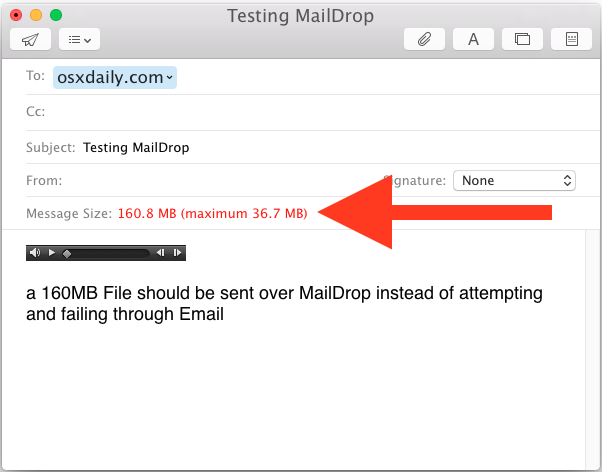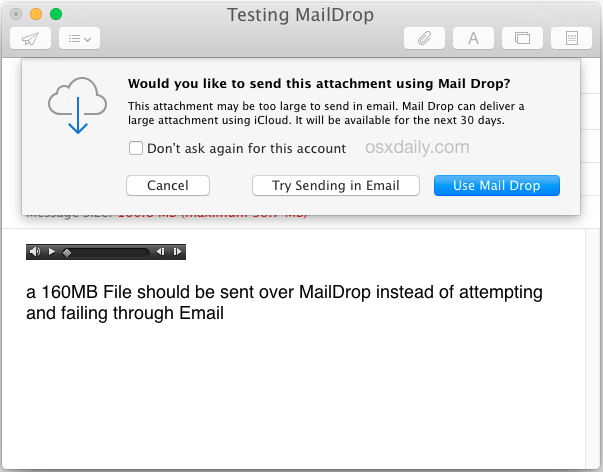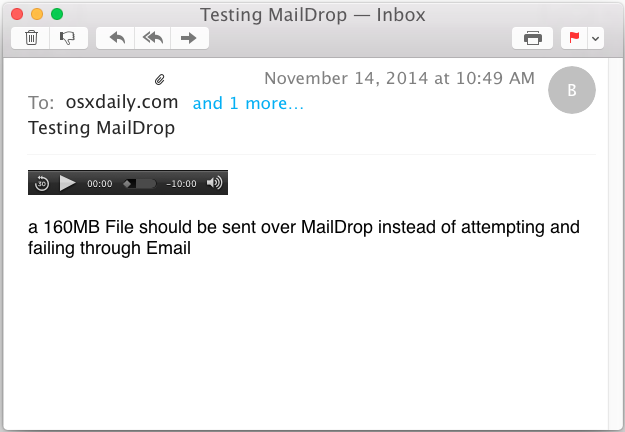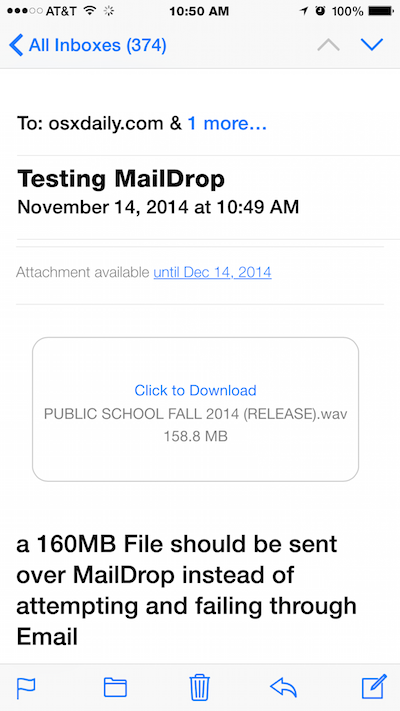How to Use Mail Drop to Send Large Files Over Email from Mac OS X
![]()
Nearly every email server has a file size limit, typically ranging between 10MB and 40MB, and any file attached to an email larger than that will typically bounce or not send. Apple has come up with an interesting solution to this problem, calling it Mail Drop.
Essentially, MailDrop will automatically detect when a large file has been placed in an email, and ask if you’d like to use Mail Drop for the attachment rather than trying (and failing) to send it through the email server. When you approve of the MailDrop request, the file is uploaded to an iCloud server where the recipient will receive a download link to the file attachment, rather than a direct email attachment. If that sounds confusing it’s really not, the entire thing is basically automated, and it works quite well.
Mail Drop was introduced in OS X Yosemite, so you as the sender will need to be running a modern version of OS X to be able to have the feature in Mail app. The recipient does not need to be running OS X Yosemite, however, as the file download link is available to any user on any platform.
Sending Large Files with Mail Drop from Mac OS X
Sending a large file or document with Mail Drop is quite simple and the process is almost entirely automated:
- From the Mac Mail app, create a new email as usual
- Attach the large file to the email, either with the attachment button, a keyboard shortcut, or with drag & drop – note how the file size will appear in red if it’s too large, this indicates it will trigger MailDrop upon send
- Attempt to send the email with the large file as usual, you’ll immediately see a pop-up window asking “Would you like to send this attachment using Mail Drop?” – select “Use Mail Drop” to begin the file upload to iCloud
- Wait until the file has finished uploading* and the email will send as usual


The download links generated from Mail Drop will remain active for 30 days and then automatically clear themselves. You can send up to 5GB this way, though keep in mind that uploading (and downloading) a 5GB file will take quit a while.
Receiving Large Files with Mail Drop
Being on the receiving end of a Mail Drop file is simple, and works on any email app or client in any OS.
- Open the new email with a large Mail Drop attachment
- Click on the “Click to Download” link – the file size of the Mail Drop attachment will be shown, this downloads from Apple iCloud servers and is quite fast
You’ll notice there’s a message saying something like “Attachment available until Jun, 14 2019”, which demonstrates the expiration date of the file (all file links expire at 30 days).
In OS X Mail app, receiving a Mail Drop file either looks like a standard file attachment with an embedded file (in the latest version of OS X), or, if received in prior versions of the Mac Mail app, it will show as a download link instead:

On the iPhone Mail app (or iPad), you receive a Mail Drop file as a download link, expiration date, and file size:

Mail Drop is a really great feature and it works flawlessly, if you plan on using this often it’s a good idea to set your default email client in Mac OS X to be Mail app, since third party apps do not support the sending of Mail Drop files – remember, other mail clients will be able to receive those files, however.
Note that if you use the remove attachment ability in Mail app for OS X, the pre-downloaded file will be removed, but the download link to Mail Drop will not be removed (until it expires, anyway).
* For those interested, when a Mail Drop file is uploading the “cloudd” process will start running in the background of OS X as the file is transferred to a remote server to then become retrievable via a download link. The cloudd process takes up about 4-7% CPU while uploading and shouldn’t have a meaningful impact on Mac performance, though it may consume much of your internet bandwidth as the file uploads from the server. Similarly, downloading the file is basically the same as downloading any other file from anywhere else online, and is limited only by the speed of your internet connection.


I am about to try to take the advice that seems to be the right one for me. thanks to all the people that had any input to my question.
Sadly, MailDrop appears to be flawed in the implementation: it derives the threshold for submitting to iCloud from your email provider’s declared maximum message size. This means that if your sending quota is larger than that of the receiver, then MailDrop cannot help you, and you cannot fix it. The solution is for Apple to have a web service probe sender and receiver mail servers for the minimum of the sizes, but that’s not how it works now. And I’d much rather SMTP servers increased their quotas (and preferably also supported eight-bit binary transfer encodings) anyway.
(Continued from my previous post). I searched my PC and there’s no sign of the file/s which it’s meant to have saved. So I do some research and it appears I need to have an iCloud account in order to access the files my client hasd sent. I don’t really need or want an iCloud account(as I already use Dropbox and don’t have any Apple devices) but figure it will be the easiest way. So it says I need to download iCloud for Windows, which I did. I then had to restart my PC. I then needed to set up an Apple ID, which I did. I then needed to verify two email addresses with Apple which I did. It then asks me to login to iCloud with my Apple ID. I do that but it tells me “This Apple ID is valid but is not an iCloud account”. Eh??!! So I do some Google searches on that statement and it turns out load of users have encountered the same problem. And it turns out that whilst yes they helpfully let you download their software version for Windows, you HAVE to have an Apple product in order to use it! Aaargh! I don’t have any Apple devices and have no intention of buying any.
My advice. Just use Dropbox rather than risk p****** off your contacts who use Windows!
Quote:” Being on the receiving end of a Mail Drop file is simple, and works on any email app or client in any OS”.
No it doesn’t! I’ve got a PC running Windows 8.1 with Outlook 2010 as my mail client. Here’s the exasperating experince I just had with it….
I just received an email from a client containing a link to files sent using Apple Mail drop. So I click on the link and it opens a web page saying “Your file will begin downloading automatically. Don’t see it? Try again>”. I waited and waited but as nothing did happen, I clicked on the “Try again” link. It open the standard Windows Open or save dialogue file window. Ahh that looks promising. BUT, it does not allow me to choose where to save the file/s. I say OK and the window disappears with no indication whether or where it has saved the file. Continued in next post…
Mail Drop works from iCloud email addresses using Verizon ISP. It does not work from Verizon email address using Verizon ISP.
And how to send mail drop items from iOS or the iCloud site?
MailDrop works nice up to 5 GB, but if you have something REALLY large, I’d rather suggest to use Filemail web app – they’ve recently introduced a 30 GB file size limit for free users, and PRO users get unlimited file sizes. Used it to send lots of 20 GB HD videos, and even to transfer a 140 GB partition backup – it always worked great.
You don’t even have to register, you just send straight from their homepage and recipients get a download link in their e-mail that stays live for 7 days (free service) or 30 days (PRO account). Hope that helps someone :)
@ht67
This feature has NOTHING to do with the size limits of ANYONE. Find a small child with a toy computer and I’m sure they can explain this to you quite well.
Thanks for this! I’m wondering how it would work if a sender attaches, say, several photos into an email, resulting in a total message size that exceeds the allowed limit. For example, I do a lot of helping older people with their Macs, and they love to attach several pics to send in an email. I always have to advise them to keep it lean, for courtesy and space sakes.
Does Maildrop automatically bundle up all attachments in an email into one link, or would the files need to be zipped into one file and then sent?
Strangely Mail Drop works perfectly for me when the recipient is using Windows or an older version of OS X, yet it’s had a 100% failure rate when the recipient is using Yosemite.
I could not get this to work in any way and it has several drawbacks anyways, if it in sometimes happens to work. Many people have still a limit of 10MB or even less. Try to send a 25MB file and see what happens.
Nice idea but there are many more solutions that work a lot better.
I’ve gotten it to work every time.
If you’re having problems with Mail Drop make sure you have iCloud enabled and for the Mail account in question, if you don’t have the email account in iCloud, it probably won’t work.
Probably common sense but some people are like “Why doesn’t Mail Drop work in Windows Outlook??” well you’re not using iCloud Mail on a Mac with Yosemite, that’s why.
The problem is how to trigger it for smaller files. I tried to send an 85MB file to a client with a Gmail address. It did not trigger Mail Drop and then Google rejected it for being too large. Is there a way to trigger Mail Drop manually, even if Mail doesn’t offer it?
I really doubt it is ever deleted. It is probably stored forever, passed around to every interested party in the world and then unencrypted (if it even was in the first place), copied, dissected, anything use full pulled out, copied and passed around some more, copyrighted then used to sue the original sender, after spamming them with ads for months first.
you’re thinking of a Google solution